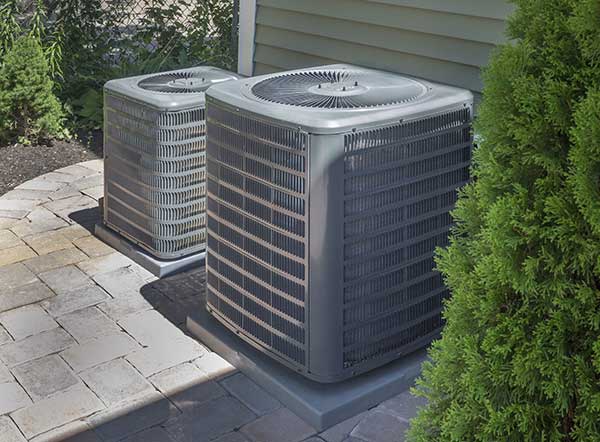When talking about energy savings and seasonal energy tips, many people might immediately think about summer. After all, summertime is when air conditioning bills can go sky-high and people are scrambling to stay cool (and stay on budget).
But there are plenty of year-round energy saving tips you can use in your home to keep comfortable and spare your wallet in winter, spring, summer, and fall. So how exactly can you maintain a balance between a comfortable temperature and energy efficiency no matter what season it is?
Glad you asked. Use this handy guide for ways to enjoy seasonal savings throughout the year without breaking the bank.
What Temperature Should I Set My Thermostat?
The laws of thermodynamics are at play when cooling or heating your home. It’s really all about the movement of heat, and depending on the season, you want to either keep the heat from coming in or leaking out. According to the U.S. Department of Energy (DOE), you can lower your energy bill by as much as 10% by turning your thermostat up by 7-10 degrees for eight hours a day in the spring and summer months, and down by that much in the fall and winter. Per the DOE’s analysis, that’s an average savings of $83 per year. Let’s take a look at some exact numbers for seasonal energy savings that also maximize financial savings.
Optimal Fall and Winter Settings
Ultimately, your comfort level will determine the temperature you choose to set your thermostat. But there are a few rules to consider to be energy efficient and cost effective:
- Energy.gov recommends that when you’re home, 68 degrees Fahrenheit is just right.
- For ideal sleep conditions, the Sleep Foundation suggests setting your thermostat to 60-67 degrees.
- When you’re away, you can turn your system down to 55 degrees if you’ll be gone for more than a few days — unless you have pets or plants. In that case, you’ll want to go with around 63 degrees.
Optimal Spring and Summer Settings
For most of us, the most comfortable home temperature is between 74-76 degrees Fahrenheit, which is about 20 degrees cooler than our average body temperature. However, depending on your cooling needs and your budget’s tolerance for cooling costs, you can adjust your thermostat setting at any time of day.
Which Is Better: A Programmable or Manual Thermostat?
When it comes to seasonal energy tips, one of the easiest ways to make a change is with your thermostat. Many people still use a manual thermostat in their homes. Unfortunately, these older thermostats are less accurate and therefore less efficient in maintaining indoor temperatures.
However, you can become more energy efficient with a programmable or smart thermostat. (No, they’re not exactly the same thing. More on that in a bit.)
These devices are readily available and affordable, so it’s worth considering this upgrade to save money and energy. Best of all, you can use them year-round, so it’s not just a summer or winter solution — they are convenient and cost-effective during the more moderate seasons as well.
By simply raising or lowering your thermostat setting by 7-10 degrees, you can save up to 10% on your energy bill every year. In spring and summer, go up; in fall and winter, go down.
How Do Programmable Thermostats Reduce Your Energy Costs Year-Round?
With a programmable thermostat, you can control your indoor temperature by setting it differently throughout the day and week. For instance, you can set the air conditioning to 83 degrees Fahrenheit while you’re at work. To bring the temperature down before you get home, program the thermostat to drop the temperature setting to 78 degrees an hour before.
In the fall or winter, with cooler temperatures outside, you can set your thermostat at 60-65 degrees while you’re away during the day, and program your system to bring it back up to 68 degrees just before you come home.
Using a programmable thermostat, you can enjoy up to 20% savings on your electricity bill.
Why Do Smart Thermostats Offer Better Control Over Your Energy Use?
A smart thermostat is programmable, but it has an advantage over regular programmable thermostats that aren’t “smart”: it can learn your household patterns and adjust temperatures accordingly.
These smart devices are also more precise, have more programmable options, and interface with your Wi-Fi network. With a smart thermostat, you can adjust and program your setting via an app from wherever you are.
Smart thermostats also track and manage your home energy use data to help you monitor your HVAC system. Like a programmable thermostat, you can save as much as 20% on your electric bill.
Should You Tune Up Your HVAC System For More Energy Savings?
While a more efficient thermostat can help lower your energy consumption, there are other important considerations: the state of your heating, ventilation, and cooling (HVAC) system, for one.
Is My HVAC System In Good Condition?
A well-maintained system operates more efficiently and ultimately saves energy and money because your HVAC system‘s age and maintenance record impact its energy efficiency. Annual service on the HVAC unit and ducting will ensure optimum system performance and extend the life of your system. In addition, regularly change the air filters to save 5–15% on your energy bill.
Is the Size of My HVAC System Right For the Size of My Home?
For the most efficient operation, your HVAC system‘s output should match your home’s size. If you have an outsized HVAC system, it will end up “short cycling,” that is, continually cycling on and off. Short cycling wastes energy.
The reverse — a system that’s too small — is also true. For example, an AC unit that’s too small for your home will run more often than it should, which is another waste of energy.
Is It Time to Upgrade My HVAC Equipment?
New HVAC systems have been manufactured to meet minimum energy efficiency standards, but some models are more efficient than others.
If it’s time to upgrade your HVAC system, be sure to check the unit’s Energy Star rating. The Environmental Protection Agency (EPA) and DOE manage the Energy Star program, which independently verifies the efficiency of various HVAC models. The energy savings you’ll see by replacing your old system with a more efficient one will show up on your utility bills.
When searching for the most efficient HVAC system, also consider the size of the space you’ll be heating and cooling. Check out this full list of Energy Star-rated heating and cooling systems.
How Can You Save on Home Heating and Cooling Costs Throughout the Year?
When the outside temperature is much warmer than the inside temperature (like in summer or even spring or early fall), the exterior heat warms the cooler interior air. Conversely, when outside temps are much cooler than your indoor temperature, that cold air can affect your comfort zone. Your windows significantly impact the temperature in your house. Here’s how you can make changes to improve energy efficiency (and your energy bill) year-round.
Will Double-or Triple-Pane Windows Translate to Bigger Savings?
Whether single-, double-, or triple-paned, the type of windows you have can make a big difference in your energy efficiency. Double-pane (or double-glazed) windows can save as much as 18% on your energy costs during warm months, and up to 24% in the colder months of winter, early spring, and fall.
Triple-pane windows are the most energy-efficient. The extra glass gives triple-glazed windows five times the insulating power over single-glazed windows– that adds up to keeping the cool air (or heat) inside your home, and vice versa when it comes to outdoor temps. The added insulation will reduce your energy costs significantly over the life of the windows.
Enter your ZIP Code and compare electricity rates
Does Insulation Make a Big Difference on Energy Savings?
Yes, insulation can make a significant difference in how much energy you save. Insulation helps reduce heat transfer through your attic or roof, whether that’s letting heat out or allowing it in. It also works the same way for walls and central air conditioning ducts. A well-insulated home means less conditioned air escapes, and it reduces the energy required to keep your indoor temperatures stable, comfortable, and safe no matter what’s going on outside. The bonus? That translates to lower utility costs year-round.
Can Weatherstripping Help Save Energy Throughout the Year?
Most of us think of weatherstripping as a solution to keep the cold out during the wintry months. After all, what’s worse than a chilly draft coming through a window or door in the dead of winter? However, it works the other way too. By sealing out the hot air during the summer or other warm times of the year, you’ll keep your HVAC system from working overtime and keep your home feeling comfortable.
There are several different types of weatherstripping for doors, ranging from foam to felt, among other materials. The same goes for window weatherstripping. Materials and procedures differ depending on the type of window you’re treating.
According to Energy.gov, sealing air leaks can save you more than 20% on heating and cooling bills.
What Are Some Fall and Winter Energy Saving Tips?
When it comes to seasonal energy tips, it doesn’t have to be a time-consuming process or major lifestyle change. Here are some simple ways to maximize your energy savings and electricity bill savings during the cooler days of autumn and winter.
Use your ceiling fans, just reverse direction: We often think of ceiling fans as a tool to keep cool in the summer, but they’ll also help you stay warm in the winter. Heat rises, so adjusting the blades to spin clockwise will help push warm air back down to circulate. Likewise, the breeze from the fan will help prevent pockets of cold air from gathering in corners. Don’t have a ceiling fan? Fall and winter can be a great time to score a good deal on one! Along with being energy efficient, they’re also beautiful and can be a wonderful addition to your home decor.
Pay attention to your fireplace: When not in use, make sure the flue is closed. Your chimney is a sneaky way for cold air to get in and warm air to escape. A pre-winter cleaning and maintenance check is a good idea. Better yet, light up a fire and enjoy the warmth and ambiance it provides. Of course, don’t forget to open the flue! Finally, look into getting an energy-efficient fire grate. Not only will it keep you and yours safe, but it will also do a great job of pulling cool air up into the chimney and pushing warm air back into the room.
Let the sunshine in: Just as you want to keep the sun out during summertime, it’s a good idea to let it shine in during winter (when it’s actually out!). The natural heat will help warm up your room and keep things nice and bright at the same time. Of course, don’t forget to close up your curtains and blinds at night to help with insulation.
Cozy up: Warm, cozy sweaters. Plush, fluffy blankets and duvets. Sherpa-lined slippers, area rugs, and carpets. These are all perfect solutions for staying warm during the crisp, cool days and nights of fall and winter. Warm winter teas and hearty comfort foods like oatmeal, soup, and pasta can also keep you warm from the inside out. You can also keep a thick, warm robe handy to make it easier to get out of bed on those cold early mornings.
Avoid this misstep: Cranking up the heat will only make your HVAC system work harder, use up more precious energy, and cost you more money on your electric bill. Use a combination of these tips provided and you’ll be on your way to having a cozy winter and autumn season.
What Are Some Spring and Summer Energy Saving Tips?
A simple and free way to save on utility costs is to open your windows overnight. Cooler nighttime temperatures dissipate the daytime’s higher temperatures. Here are more details on how to stay cool during the hot days of summer:
Open the windows: The cool air of the night and early morning hours means you can turn off your central air conditioning and enjoy comfortable temperatures overnight. Then, in the morning, close up the house to retain the lower temperature for as long as possible.
Improve window treatments: For the same reason as opening your windows at night, draw the curtains or blinds before the sun has a chance to heat up the day. You can reduce the amount of heat inside your home by 33% in summer when you invest in thermal-backed draperies to block the sun. Honeycomb blinds work on the same principle and are a good option.
Improve ventilation: If you have an attic exhaust fan, invest in a smart or programmable thermostat to remove hot air from your attic and crawl spaces. You’ll eliminate the radiant heat of the trapped hot air and keep your AC unit from working hard to compensate for it.
Use ceiling fans: Traditional fans and ceiling fans can save on your AC unit‘s operational costs. While the temperature difference between inside and outside is minimal, fans can help cool your home. They won’t replace your air conditioner, but the longer you can delay its operation, the more you’ll save on energy consumption and reduce your utility costs.
If you use ceiling fans, set the fan blades to turn counter-clockwise, which will push air down. You can even raise your thermostat setting by 4 degrees without reducing your air conditioner‘s cooling effect.
Control humidity: Whether your climate is hot and muggy or hot and dry, controlling the humidity in your living space will help you feel more comfortable. For hot, humid climates, you’ll want a dehumidifier. When it’s a dry heat, a humidifier can lower your body temperature.
Avoid cooking: Any internal heat source, such as an oven or stovetop — even the dishwasher and dryer — puts a strain on your air conditioner. Instead, fire up the grill or make a salad for dinner. Or if you need to cook, use the toaster oven or microwave, which consume far less energy than a full-size oven.
Air dry your laundry: Take advantage of the warm weather to hang your laundry outside. You’ll save money and let nature do all the work to dry your clothes and linens.
Avoid this mistake: Many think a lower setting on their thermostat makes the AC unit work faster. When you come home at the end of the day or if you’ve been away for several days, don’t come in and set the AC for 68 degrees Fahrenheit. It won’t cool things down any faster, and it comes with unnecessary expense. A higher temperature inside will slow the heat flow into your house, so save energy and money with your average temperature setting of 78 degrees Fahrenheit.
Use These Seasonal Energy Tips and Get Ready to Maximize Savings and Comfort
We all want to feel comfortable at home, whether it’s during the summer’s high temperatures or winter’s frosty chill. Fortunately, there are plenty of ways to maintain a comfortable indoor temperature without sacrificing your energy savings and utility costs.
Consider investing in a smart thermostat if you don’t already have one. This is one of the easiest and most inexpensive ways to manage your central air conditioning or heat. A smart thermostat can help you easily manage your comfort levels anytime. Remember, whether it’s winter, fall, spring, or summer, properly programming your thermostat can help you save energy as well as heating and cooling costs.
It can also be worth every penny to install a new Energy Star-rated heating and cooling system if you have an older HVAC unit. An energy-efficient HVAC system will pay you back year-round, over the life of the equipment.
There are also many other small, low-cost (and cost-free) changes you can make that can result in big savings. For instance, weatherstripping will keep your home well-insulated during both sweltering and freezing months. You can also adopt simple tricks like changing the direction of your ceiling fan blades to help you feel more comfortable year-round.
For more helpful ideas on energy efficiency, keep browsing our Energy Savings blog. Also, consider reviewing your current energy plan to see how you can save even more.
Brought to you by energysavings.com
All images licensed from Adobe Stock.
Featured image:




